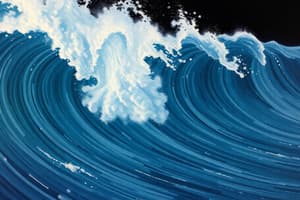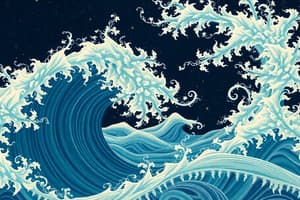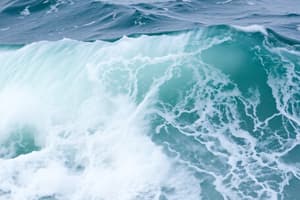Podcast
Questions and Answers
Consider two waves traveling in the same medium. How does a change in wavelength of one wave affect its speed, assuming the medium remains constant?
Consider two waves traveling in the same medium. How does a change in wavelength of one wave affect its speed, assuming the medium remains constant?
- Both waves will have the same speed regardless of their wavelengths. (correct)
- The speed of the waves will vary non-linearly with the inverse square of the wavelength.
- The wave with a longer wavelength will travel faster.
- The wave with a shorter wavelength will travel faster.
A wave transitions from air into water. Which property of the wave remains unchanged during the transition?
A wave transitions from air into water. Which property of the wave remains unchanged during the transition?
- Amplitude
- Wavelength
- Speed
- Frequency (correct)
What is the relationship between the frequency ($f$) and the period ($T$) of a wave?
What is the relationship between the frequency ($f$) and the period ($T$) of a wave?
- $f = \sqrt{T}$
- $f = T$
- $f = T^2$
- $f = 1/T$ (correct)
Given a wave with a frequency of 5 Hz and a wavelength of 2 meters, what is the speed of the wave?
Given a wave with a frequency of 5 Hz and a wavelength of 2 meters, what is the speed of the wave?
Which part of a transverse wave is characterized as the lowest point below its equilibrium position?
Which part of a transverse wave is characterized as the lowest point below its equilibrium position?
How is the wavelength ($\lambda$) defined in the context of a wave?
How is the wavelength ($\lambda$) defined in the context of a wave?
If the frequency of a wave is doubled while it travels through the same medium, what happens to its wavelength?
If the frequency of a wave is doubled while it travels through the same medium, what happens to its wavelength?
Consider two waves, Wave A and Wave B, traveling through different media. Wave A has a higher speed than Wave B. Which of the following conclusions can be accurately drawn?
Consider two waves, Wave A and Wave B, traveling through different media. Wave A has a higher speed than Wave B. Which of the following conclusions can be accurately drawn?
How does increasing the frequency of a wave affect its properties upon entering a different medium, assuming the wave speed remains constant?
How does increasing the frequency of a wave affect its properties upon entering a different medium, assuming the wave speed remains constant?
If the amplitude of a wave is doubled and the frequency is halved, what is the resulting change in the wave's intensity?
If the amplitude of a wave is doubled and the frequency is halved, what is the resulting change in the wave's intensity?
A sound wave traveling through air has a period of 400 microseconds. What is the frequency of this wave?
A sound wave traveling through air has a period of 400 microseconds. What is the frequency of this wave?
What occurs when a transverse wave traveling in a denser medium is incident on a rarer medium?
What occurs when a transverse wave traveling in a denser medium is incident on a rarer medium?
Given that the intensity of a wave is directly proportional to the square of its amplitude and frequency, how would you explain the relationship mathematically if 'k' is the proportionality constant?
Given that the intensity of a wave is directly proportional to the square of its amplitude and frequency, how would you explain the relationship mathematically if 'k' is the proportionality constant?
Consider two waves with amplitudes A1 and A2. What condition must be met for their superposition to result in complete destructive interference at a point?
Consider two waves with amplitudes A1 and A2. What condition must be met for their superposition to result in complete destructive interference at a point?
A transverse wave is reflected from a boundary. Under what conditions would the reflected wave undergo a phase shift of $\pi$ radians?
A transverse wave is reflected from a boundary. Under what conditions would the reflected wave undergo a phase shift of $\pi$ radians?
If a wave's frequency is tripled while its speed remains constant, what happens to its period?
If a wave's frequency is tripled while its speed remains constant, what happens to its period?
A string with a linear mass density of $5.00 \times 10^{-3}$ kg/m is under a tension of 80.0 N. What is the speed of the wave produced in the string?
A string with a linear mass density of $5.00 \times 10^{-3}$ kg/m is under a tension of 80.0 N. What is the speed of the wave produced in the string?
A stretched steel wire is 1 m long and has a fundamental frequency of 250 Hz. What is the velocity of the transverse wave in it?
A stretched steel wire is 1 m long and has a fundamental frequency of 250 Hz. What is the velocity of the transverse wave in it?
How is the number of antinodes (N) related to the harmonic number (H) for standing waves?
How is the number of antinodes (N) related to the harmonic number (H) for standing waves?
What distinguishes the fundamental frequency from overtones in the context of waves?
What distinguishes the fundamental frequency from overtones in the context of waves?
A guitar string is vibrating at its third harmonic. If the length of the string is $L$, what is the distance between two consecutive nodes?
A guitar string is vibrating at its third harmonic. If the length of the string is $L$, what is the distance between two consecutive nodes?
Consider two strings of identical length and tension. String A has a linear mass density twice that of String B. What is the ratio of the fundamental frequency of String A to that of String B?
Consider two strings of identical length and tension. String A has a linear mass density twice that of String B. What is the ratio of the fundamental frequency of String A to that of String B?
A string fixed at both ends vibrates in its fifth harmonic. At what points along the string (excluding the endpoints) can you touch the string without disturbing the standing wave?
A string fixed at both ends vibrates in its fifth harmonic. At what points along the string (excluding the endpoints) can you touch the string without disturbing the standing wave?
A standing wave is formed on a string of length $L$ fixed at both ends. If the frequency of the wave is doubled, which of the following is true about the new standing wave pattern?
A standing wave is formed on a string of length $L$ fixed at both ends. If the frequency of the wave is doubled, which of the following is true about the new standing wave pattern?
In the context of sound wave interference, what condition primarily dictates whether the interference will be constructive or destructive?
In the context of sound wave interference, what condition primarily dictates whether the interference will be constructive or destructive?
What is the primary requirement for sound sources to be considered coherent in the context of interference?
What is the primary requirement for sound sources to be considered coherent in the context of interference?
How does the path difference between two sound waves relate to the type of interference that occurs?
How does the path difference between two sound waves relate to the type of interference that occurs?
In what scenario does a 'silence zone' typically occur in the context of sound wave interference?
In what scenario does a 'silence zone' typically occur in the context of sound wave interference?
What is the effect of destructive interference on the loudness and intensity of sound?
What is the effect of destructive interference on the loudness and intensity of sound?
What occurs when the compression of one sound wave aligns with the rarefaction of another wave at a specific point?
What occurs when the compression of one sound wave aligns with the rarefaction of another wave at a specific point?
Why is it essential for sound waves to travel in the same medium to observe interference effects?
Why is it essential for sound waves to travel in the same medium to observe interference effects?
In the context of constructive sound interference, how does the resulting sound differ from the individual sounds that interfere?
In the context of constructive sound interference, how does the resulting sound differ from the individual sounds that interfere?
Under what conditions does constructive interference of sound waves predominantly occur?
Under what conditions does constructive interference of sound waves predominantly occur?
What is the fundamental principle that governs the superposition of waves in a medium?
What is the fundamental principle that governs the superposition of waves in a medium?
Consider $n$ waves acting simultaneously on a particle in a medium. If the displacement due to each wave is given by $y_i$, where $i$ ranges from 1 to $n$, what is the resultant displacement $Y$ of the particle?
Consider $n$ waves acting simultaneously on a particle in a medium. If the displacement due to each wave is given by $y_i$, where $i$ ranges from 1 to $n$, what is the resultant displacement $Y$ of the particle?
Two identical sound waves are propagating in the same direction through a medium. What phenomenon occurs when these waves 'mix up' or combine?
Two identical sound waves are propagating in the same direction through a medium. What phenomenon occurs when these waves 'mix up' or combine?
What happens to the energy of two waves that interfere destructively?
What happens to the energy of two waves that interfere destructively?
How does the principle of superposition apply when analyzing complex soundscapes, such as in an orchestra?
How does the principle of superposition apply when analyzing complex soundscapes, such as in an orchestra?
In the context of sound interference, what distinguishes 'identical' waves from similar waves with slightly different characteristics?
In the context of sound interference, what distinguishes 'identical' waves from similar waves with slightly different characteristics?
If two identical sound waves with amplitudes $A_1$ and $A_2$ interfere constructively at a point, and $A_1 = A_2 = A$, what is the amplitude of the resulting wave at that point?
If two identical sound waves with amplitudes $A_1$ and $A_2$ interfere constructively at a point, and $A_1 = A_2 = A$, what is the amplitude of the resulting wave at that point?
Two identical sound waves, each with amplitude $A$, interfere in a medium. Under what conditions regarding their phase difference ($\phi$) will the resulting wave have an amplitude of $\frac{A}{2}$?
Two identical sound waves, each with amplitude $A$, interfere in a medium. Under what conditions regarding their phase difference ($\phi$) will the resulting wave have an amplitude of $\frac{A}{2}$?
Consider two sound waves with amplitudes $A_1$ and $A_2$ interfering destructively. If the resulting amplitude is zero, what can be definitively concluded about the relationship between the initial waves at the point of interference?
Consider two sound waves with amplitudes $A_1$ and $A_2$ interfering destructively. If the resulting amplitude is zero, what can be definitively concluded about the relationship between the initial waves at the point of interference?
A string is fixed at both ends and supports a standing wave with three nodes (including the endpoints). If the length of the string is $L$, what is the wavelength of the standing wave?
A string is fixed at both ends and supports a standing wave with three nodes (including the endpoints). If the length of the string is $L$, what is the wavelength of the standing wave?
A pipe, open at both ends, has a fundamental frequency $f$. If one end of the pipe is closed, what is the new fundamental frequency, assuming the speed of sound remains constant?
A pipe, open at both ends, has a fundamental frequency $f$. If one end of the pipe is closed, what is the new fundamental frequency, assuming the speed of sound remains constant?
The velocity of sound in air at a certain temperature is $v$. If the absolute temperature is doubled and the molar mass of the gas is quadrupled, what is the new velocity of sound?
The velocity of sound in air at a certain temperature is $v$. If the absolute temperature is doubled and the molar mass of the gas is quadrupled, what is the new velocity of sound?
Two speakers emit sound waves of the same frequency and amplitude. At a certain point, the sound intensity is four times what it would be from a single speaker alone. What is the phase difference between the waves at this point?
Two speakers emit sound waves of the same frequency and amplitude. At a certain point, the sound intensity is four times what it would be from a single speaker alone. What is the phase difference between the waves at this point?
A stationary wave is formed by the superposition of two waves, $y_1 = A\sin(kx - \omega t)$ and $y_2 = A\sin(kx + \omega t)$. What is the distance between two consecutive nodes in the resulting wave?
A stationary wave is formed by the superposition of two waves, $y_1 = A\sin(kx - \omega t)$ and $y_2 = A\sin(kx + \omega t)$. What is the distance between two consecutive nodes in the resulting wave?
Consider a scenario where two identical sound sources are emitting waves in phase. At a certain point, the path difference to the listener is $\lambda/2$, where $\lambda$ is the wavelength. If the amplitude of each wave is $A$, what is the resulting amplitude at the listener's location?
Consider a scenario where two identical sound sources are emitting waves in phase. At a certain point, the path difference to the listener is $\lambda/2$, where $\lambda$ is the wavelength. If the amplitude of each wave is $A$, what is the resulting amplitude at the listener's location?
Flashcards
Constructive Interference
Constructive Interference
When two waves meet in phase, amplifying sound and increasing loudness.
Destructive Interference
Destructive Interference
When two waves meet out of phase, canceling each other, reducing sound intensity.
Conditions for Interference
Conditions for Interference
Requires coherent sound sources, same frequency, and proximity of sources.
Echoing Zone
Echoing Zone
Signup and view all the flashcards
Silence Zone
Silence Zone
Signup and view all the flashcards
Path Difference
Path Difference
Signup and view all the flashcards
Coherent Sources
Coherent Sources
Signup and view all the flashcards
Wave Medium
Wave Medium
Signup and view all the flashcards
Crest
Crest
Signup and view all the flashcards
Trough
Trough
Signup and view all the flashcards
Wavelength
Wavelength
Signup and view all the flashcards
Wave Speed
Wave Speed
Signup and view all the flashcards
Frequency
Frequency
Signup and view all the flashcards
Equilibrium Position
Equilibrium Position
Signup and view all the flashcards
Different Medium
Different Medium
Signup and view all the flashcards
Wave Intensity
Wave Intensity
Signup and view all the flashcards
Amplitude
Amplitude
Signup and view all the flashcards
Sound wave frequency
Sound wave frequency
Signup and view all the flashcards
Reflection of waves
Reflection of waves
Signup and view all the flashcards
Transverse wave
Transverse wave
Signup and view all the flashcards
Phase Difference
Phase Difference
Signup and view all the flashcards
Velocity of Sound
Velocity of Sound
Signup and view all the flashcards
Temperature and Sound Velocity
Temperature and Sound Velocity
Signup and view all the flashcards
Stationary Waves
Stationary Waves
Signup and view all the flashcards
Nodes and Antinodes
Nodes and Antinodes
Signup and view all the flashcards
Antinode
Antinode
Signup and view all the flashcards
Harmonic Number
Harmonic Number
Signup and view all the flashcards
Fundamental Frequency
Fundamental Frequency
Signup and view all the flashcards
Overtone
Overtone
Signup and view all the flashcards
Linear Mass Density
Linear Mass Density
Signup and view all the flashcards
Wave Speed Formula
Wave Speed Formula
Signup and view all the flashcards
Tension in a String
Tension in a String
Signup and view all the flashcards
Calculating Harmonic Number from Overtone
Calculating Harmonic Number from Overtone
Signup and view all the flashcards
Total Displacement
Total Displacement
Signup and view all the flashcards
Principle of Superposition
Principle of Superposition
Signup and view all the flashcards
Interference of Sound
Interference of Sound
Signup and view all the flashcards
Identical Waves
Identical Waves
Signup and view all the flashcards
Resultant Displacement
Resultant Displacement
Signup and view all the flashcards
Medium in Sound Waves
Medium in Sound Waves
Signup and view all the flashcards
Study Notes
Learning Objectives
- Define and apply wave model terms: medium, displacement, amplitude, period, compression, rarefaction, crest, trough, wavelength, and velocity.
- Solve problems using the equation: v = fλ.
- Describe energy transfer due to progressive waves.
- Compare transverse and longitudinal waves.
- Explain the factors affecting sound speed in a medium and describe Newton's formula, including the Laplace correction.
- Identify factors influencing sound speed in air.
- Describe superposition of waves from coherent sources.
- Describe the phenomenon of sound wave interference.
- Describe wave motion using ropes and springs.
- Show that mechanical waves need a medium for propagation but electromagnetic waves do not.
- Explain stationary waves graphically.
- Define the terms node and antinode.
- Describe string vibrations.
- Describe stationary waves in vibrating air columns.
- Explain the principle of superposition.
- Explain Simple Harmonic Motion (SHM) and its characteristics.
Wave Speed
- Wave speed can be measured by timing a wave crest's movement over a distance.
- Wave speed is determined from frequency and wavelength (v = fλ).
- In a single medium (like air or vacuum), waves of different frequencies have the same speed but different wavelengths.
- In different mediums, the frequency remains the same, but the wavelength and speed change.
Intensity of a Wave
- Intensity is directly proportional to the square of amplitude and frequency.
Reflection of Transverse Waves
- Reflection occurs when a transverse wave encounters a denser medium with a 180° phase change.
- Reflection occurs without a phase change when encountering a rarer medium.
Sound
- Sound is a mechanical wave produced by a vibrating source.
- Sound travels as longitudinal waves in mediums like air, water, and solids.
- Sound waves result from compressions and rarefactions in the medium.
Wave Speed in a Medium
- Speed of sound depends on the medium's elasticity and density:
Newton's Formula for Sound Speed
- Newton calculated sound speed using the bulk modulus of elasticity and density.
- The calculated value differed from experimental results.
Laplace's Correction
- Laplace corrected Newton's formula, accounting for adiabatic processes in air, which significantly improves the result.
Audible Range
- Humans hear frequencies between 20 Hz and 20,000 Hz.
- Waves below 20 Hz are infrasonic, above 20,000 Hz are ultrasonic.
Doppler Effect
- Doppler effect describes a change in the perceived frequency of a wave when the source or observer moves relative to each other.
- The frequency increases if the source is moving towards the observer and decreases if moving away.
- Similarly, an observer's motion towards or away from a stationary source also changes the perceived frequency.
Standing or Stationary Waves
- When similar waves traveling in opposite directions combine, they form stationary waves.
- These waves have points of zero displacement (nodes) and maximum displacement (antinodes).
- The distance between successive nodes or antinodes is λ/2.
- Stationary waves have alternating potential and kinetic energy as particles vibrate.
Organ Pipes
- Organ pipes produce sounds due to stationary waves in air columns.
- Open organ pipes have antinodes at both ends, resulting in certain frequencies.
- Closed organ pipes have a node at one end and an antinode at the other, producing different frequencies
Standing Waves on a String
- These waves show characteristic nodes and antinodes.
- Their speed depends on string tension and linear density.
Combinations of Springs
- Springs in series have an inverse relationship to their equivalent spring constant
- Springs in parallel have an additive relationship to their equivalent spring constant
Simple Harmonic Motion (SHM)
- SHM characteristics:
- Acceleration is directly proportional to displacement.
- Displacement is always directed towards a mean position.
Studying That Suits You
Use AI to generate personalized quizzes and flashcards to suit your learning preferences.




